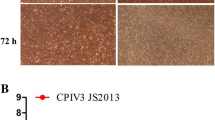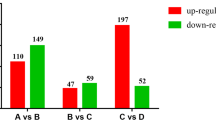Abstract
Rabies is a neglected tropical disease caused by the rabies virus (RABV) and it is mostly transmitted to humans by dogs. However, knowledge about host factors and their role in RABV infection in dogs is still limited. This is the first study to identify differentially expressed dog brain proteins involved in naturally occurring rabies virus infection using iTRAQ-based proteomics approach. Here, we have reported 19 differentially expressed proteins (DEPs) in RABV infected dog brain compared to controls and some of these proteins are the first time reported. GO annotation revealed their involvement in various molecular functions and also their participation in cellular processes, biological regulation, and metabolic processes. Further, ingenuity pathway analysis (IPA) predicted the major protein network showing the connection of 13 DEPs and their role in some of the canonical pathways. IPA analysis also predicted their involvement in neurological disease, organismal injury and abnormalities, psychological disorders. Proteomics data were successfully validated at gene expression levels by qRT-PCR for five DEPs including two down-regulated proteins namely DDX3X and SNCB and three up-regulated proteins namely KCTD12, DLA-64 and IgSF. This study provides the list of molecules involved in RABV infection and gives some insight into the molecular pathophysiology involved in this infection. This also suggests that DE proteins like DDX3X may have importance in RABV replication similar to other viruses. However, further experiments are required to confirm the role of these proteins in the molecular mechanism of RABV infection.




Similar content being viewed by others
References
Bortz E, Garcia-Sastre A (2011) Predicting the pathogenesis of influenza from genomic response: a step toward early diagnosis. Genome Med 3:67. https://doi.org/10.1186/gm283
Bradford MM (1976) A rapid and sensitive method for the quantitation of microgram quantities of protein utilizing the principle of protein-dye binding. Anal Biochem 72:248–254. https://doi.org/10.1006/abio.1976.9999
Brown RH, Al-Chalabi A (2017) Amyotrophic lateral sclerosis. N Engl J Med 377:162–172. https://doi.org/10.1056/NEJMra1603471
Dhingra V, Li X, Liu Y, Fu ZF (2007) Proteomic profiling reveals that rabies virus infection results in differential expression of host proteins involved in ion homeostasis and synaptic physiology in the central nervous system. J Neurovirol 13:107–117. https://doi.org/10.1080/13550280601178226
Farahtaj F, Zandi F, Khalaj V, Biglari P, Fayaz A, Vaziri B (2013) Proteomics analysis of human brain tissue infected by street rabies virus. Mol Biol Rep 40:6443–6450. https://doi.org/10.1007/s11033-013-2759-0
Farahtaj F et al (2019) Natural infection with rabies virus: a histopathological and immunohistochemical study of human brains osong. Public Health Res Perspect 10:6–11. https://doi.org/10.24171/j.phrp.2019.10.1.03
Fooks AR et al (2017) Rabies. Nat Rev Dis Prim 3:17091. https://doi.org/10.1038/nrdp.2017.91
Fu ZF, Li X, Dhingra V (2008) Pathogenic rabies virus alters host protein expression in the central nervous system: implications for neuronal dysfunction. Dev Biol (Basel) 131:83–91
Glover T, Mitchell K (2008) An introduction to biostatistics. Waveland Press, Long Grove
Gupta PK, Chaturvedi VK, Verma PC, Pandey KD (2015) Differentiation of rabies fixed and street viruses using RT-PCR coupled with restriction endonuclease analysis. Indian J Biotechnol 4:284–286
Hampson K et al (2015) Estimating the global burden of endemic canine rabies. PLoS Negl Trop Dis 9:e0003709. https://doi.org/10.1371/journal.pntd.0003709
Hasegawa T et al (2013) Use of potassium channel tetramerization domain-containing 12 as a biomarker for diagnosis and prognosis of gastrointestinal stromal tumor. Hum Pathol 44:1271–1277. https://doi.org/10.1016/j.humpath.2012.10.013
Hashimoto M, Rockenstein E, Mante M, Mallory M, Masliah E (2001) beta-Synuclein inhibits alpha-synuclein aggregation: a possible role as an anti-parkinsonian factor. Neuron 32:213–223. https://doi.org/10.1016/s0896-6273(01)00462-7
Ishaq M, Hu J, Wu X, Fu Q, Yang Y, Liu Q, Guo D (2008) Knockdown of cellular RNA helicase DDX3 by short hairpin RNAs suppresses HIV-1 viral replication without inducing apoptosis. Mol Biotechnol 39:231–238. https://doi.org/10.1007/s12033-008-9040-0
Khadivjam B, Stegen C, Hogue-Racine MA, El Bilali N, Dohner K, Sodeik B, Lippe R (2017) The ATP-dependent RNA helicase DDX3X modulates herpes simplex virus 1 gene expression. J Virol. https://doi.org/10.1128/JVI.02411-16
Lahaye X, Vidy A, Fouquet B, Blondel D (2012) Hsp70 protein positively regulates rabies virus infection. J Virol 86:4743–4751. https://doi.org/10.1128/JVI.06501-11
Lasonder E (2017) Clinical proteomics: from biological sample to clinical exploitation. Proteomes. https://doi.org/10.3390/proteomes5020010
Li C et al (2014) Cellular DDX3 regulates Japanese encephalitis virus replication by interacting with viral un-translated regions. Virology 449:70–81. https://doi.org/10.1016/j.virol.2013.11.008
Li G, Feng T, Pan W, Shi X, Dai J (2015) DEAD-box RNA helicase DDX3X inhibits DENV replication via regulating type one interferon pathway. Biochem Biophys Res Commun 456:327–332. https://doi.org/10.1016/j.bbrc.2014.11.080
Li L et al (2016) Interferon-inducible GTPase: a novel viral response protein involved in rabies virus infection. Adv Virol 161:1285–1293. https://doi.org/10.1007/s00705-016-2795-x
Livak KJ, Schmittgen TD (2001) Analysis of relative gene expression data using real-time quantitative PCR and the 2(-Delta Delta C(T)) method. Methods 25:402–408. https://doi.org/10.1006/meth.2001.1262
Mehta S, Sreenivasamurthy S, Banerjee S, Mukherjee S, Prasad K, Chowdhary A (2016) Pathway analysis of proteomics profiles in rabies infection: towards future biomarkers? OMICS 20:97–109. https://doi.org/10.1089/omi.2015.0137
Meier-Stephenson V, Mrozowich T, Pham M, Patel TR (2018) DEAD-box helicases: the Yin and Yang roles in viral infections. Biotechnol Genet Eng Rev 34:3–32. https://doi.org/10.1080/02648725.2018.1467146
Meslin FX, Kaplan MM, Koprowski H, World Health Organization (1996) Laboratory techniques in rabies, 4th ed. World Health Organization. https://apps.who.int/iris/handle/10665/38286
Monroy-Gomez J, Santamaria G, Torres-Fernandez O (2018) Overexpression of MAP2 and NF-H associated with dendritic pathology in the spinal cord of mice infected with rabies virus. Viruses. https://doi.org/10.3390/v10030112
Mukherjee S, Bandyopadhyay A (2016) Proteomics in India: the clinical aspect. Clin Proteom 13:21. https://doi.org/10.1186/s12014-016-9122-0
Nadin-Davis SA, Huang W, Wandeler AI (1996) The design of strain-specific polymerase chain reactions for discrimination of the racoon rabies virus strain from indigenous rabies viruses of Ontario. J Virol Methods 57:1–14. https://doi.org/10.1016/0166-0934(95)01907-3
Nagaraj T, Vasanth JP, Desai A, Kamat A, Madhusudana SN, Ravi V (2006) Ante mortem diagnosis of human rabies using saliva samples: comparison of real time and conventional RT-PCR techniques. J Clin Virol 36:17–23. https://doi.org/10.1016/j.jcv.2006.01.009
Perez-Riverol Y et al (2019) The PRIDE database and related tools and resources in 2019: improving support for quantification data. Nucleic Acids Res 47:D442–D450. https://doi.org/10.1093/nar/gky1106
Rahimpour M, Soheili M, Eslami N, Fayaz A, Sardari S, Vaziri B (2007) Carrier ampholyte isoelectric focusing based two-dimensional electrophoresis in preliminary screening of differential proteomics analysis. Chromatographia 66:133–136. https://doi.org/10.1365/s10337-007-0247-1
Rajagopalan D, Agarwal P (2005) Inferring pathways from gene lists using a literature-derived network of biological relationships. Bioinformatics 21:788–793. https://doi.org/10.1093/bioinformatics/bti069
Randall G et al (2007) Cellular cofactors affecting hepatitis C virus infection and replication. Proc Natl Acad Sci USA 104:12884–12889. https://doi.org/10.1073/pnas.0704894104
Schwenk J et al (2010) Native GABA(B) receptors are heteromultimers with a family of auxiliary subunits. Nature 465:231–235. https://doi.org/10.1038/nature08964
Shilov IV et al (2007) The Paragon Algorithm, a next generation search engine that uses sequence temperature values and feature probabilities to identify peptides from tandem mass spectra. Mol Cell Proteom MCP 6:1638–1655. https://doi.org/10.1074/mcp.T600050-MCP200
Sudarshan M (2017) Vision 2030: dog-mediated human rabies-free India: action must begin now. Indian J Public Health 61:1–2. https://doi.org/10.4103/ijph.IJPH_20_17
Sugiura N et al (2011) Gene expression analysis of host innate immune responses in the central nervous system following lethal CVS-11 infection in mice. Jpn J Infect Dis 64:463–472
Sun C, Pager CT, Luo G, Sarnow P, Cate JH (2010) Hepatitis C virus core-derived peptides inhibit genotype 1b viral genome replication via interaction with DDX3X. PLoS ONE. https://doi.org/10.1371/journal.pone.0012826
Sun X, Shi N, Li Y, Dong C, Zhang M, Guan Z, Duan M (2016) Quantitative proteome profiling of street rabies virus-infected mouse hippocampal synaptosomes. Curr Microbiol 73:301–311. https://doi.org/10.1007/s00284-016-1061-5
Suryawanshi AR, Khan SA, Gajbhiye RK, Gurav MY, Khole VV (2011) Differential proteomics leads to identification of domain-specific epididymal sperm proteins. J Androl 32:240–259. https://doi.org/10.2164/jandrol.110.010967
Szappanos D et al (2018) The RNA helicase DDX3X is an essential mediator of innate antimicrobial immunity. PLoS Pathog 14:e1007397. https://doi.org/10.1371/journal.ppat.1007397
Taschenberger G et al (2013) beta-synuclein aggregates and induces neurodegeneration in dopaminergic neurons. Ann Neurol 74:109–118. https://doi.org/10.1002/ana.23905
Thanomsridetchai N et al (2011) Comprehensive proteome analysis of hippocampus, brainstem, and spinal cord from paralytic and furious dogs naturally infected with rabies. J Proteom Res 10:4911–4924. https://doi.org/10.1021/pr200276u
Thoulouze MI, Lafage M, Schachner M, Hartmann U, Cremer H, Lafon M (1998) The neural cell adhesion molecule is a receptor for rabies virus. J Virol 72:7181–7190
Thulasi Raman SN et al (2016) DDX3 interacts with influenza A Virus NS1 and NP proteins and exerts antiviral function through regulation of stress granule formation. J Virol 90:3661–3675. https://doi.org/10.1128/JVI.03010-15
Tsiang H, de la Porte S, Ambroise DJ, Derer M, Koenig J (1986) Infection of cultured rat myotubes and neurons from the spinal cord by rabies virus. J Neuropathol Exp Neurol 45:28–42. https://doi.org/10.1097/00005072-198601000-00003
Vaziri B, Torkashvand F, Eslami N, Fayaz A (2012) Comparative proteomics analysis of mice lymphocytes in early stages of infection by different strains of rabies virus. Indian J Virol 23:311–316. https://doi.org/10.1007/s13337-012-0093-0
Venugopal AK et al (2013) Quantitative proteomics for identifying biomarkers for Rabies. Clin Proteom 10:3. https://doi.org/10.1186/1559-0275-10-3
Vyas JM, Van der Veen AG, Ploegh HL (2008) The known unknowns of antigen processing and presentation. Nat Rev Immunol 8:607–618. https://doi.org/10.1038/nri2368
Wang X et al (2011) Proteomic profiles of mouse neuro N2a cells infected with variant virulence of rabies viruses. J Microbiol Biotechnol 21:366–373
WHO (2007) Rabies: general aspect and laboratory diagnostic techniques. WHO, Geneva
Yang Y et al (2015) iTRAQ protein profile analysis of neuroblastoma (NA) cells infected with the rabies viruses rHep-Flury and Hep-dG. Front Microbiol 6:691. https://doi.org/10.3389/fmicb.2015.00691
Zandi F, Eslami N, Soheili M, Fayaz A, Gholami A, Vaziri B (2009) Proteomics analysis of BHK-21 cells infected with a fixed strain of rabies virus. Proteomics 9:2399–2407. https://doi.org/10.1002/pmic.200701007
Zandi F, Eslami N, Torkashvand F, Fayaz A, Khalaj V, Vaziri B (2013) Expression changes of cytoskeletal associated proteins in proteomic profiling of neuroblastoma cells infected with different strains of rabies virus. J Med Virol 85:336–347. https://doi.org/10.1002/jmv.23458
Author information
Authors and Affiliations
Corresponding authors
Additional information
Publisher's Note
Springer Nature remains neutral with regard to jurisdictional claims in published maps and institutional affiliations.
Electronic supplementary material
Below is the link to the electronic supplementary material.
42485_2020_51_MOESM2_ESM.tif
Supplementary Figure 2: Representative results of various tests for rabies virus infection A. the presence of Negri bodies with Seller’s staining method, B. Direct Fluorescent Antibody Test (dFAT) showing fine dusty particles emitting bright apple green color fluorescence were considered positive for the presence of rabies virus antigen, C. The amplification of 762 bp region of nucleoprotein (N) gene and D. 406 bp region of glycoprotein, (G) gene of rabies virus (tif 1401 kb)
42485_2020_51_MOESM3_ESM.xlsx
Supplementary Table 1: List of down-regulated and up-regulated dog brain proteins expressed in RABV infection along with their mass spectrometry details (xlsx 15 kb)
42485_2020_51_MOESM4_ESM.xlsx
Supplementary Table 2: List of all identified dog brain proteins along with their mass spectrometry details (xlsx 76 kb)
Rights and permissions
About this article
Cite this article
Behera, S., Pharande, R.R., Reddy, R.R. et al. Quantitative proteomics leads to identify dog brain proteins involved in rabies virus infection: implication in understanding viral pathophysiology. J Proteins Proteom 11, 241–257 (2020). https://doi.org/10.1007/s42485-020-00051-w
Received:
Revised:
Accepted:
Published:
Issue Date:
DOI: https://doi.org/10.1007/s42485-020-00051-w




